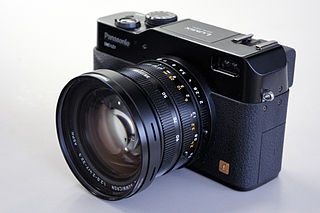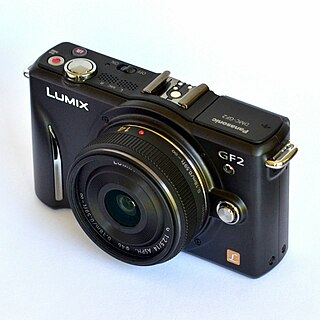Related Research Articles

Lumix is Panasonic's brand of digital cameras, ranging from pocket point-and-shoot models to digital SLRs.

The Panasonic Lumix DMC-FZ8 is a 7 megapixel superzoom bridge digital camera made by Panasonic. As with most Panasonic Lumix cameras, it uses a Venus Engine, in this case, the Venus Engine III. It supports the Raw image format and has the same sensor size and zoom level as its predecessor, the Panasonic Lumix DMC-FZ7.

The Lumix DMC-L10 is Panasonic's second digital single-lens reflex camera (DSLR), a follow-up to the previous Lumix DMC-L1 model. It was announced in August 2007, and, like the Lumix DMC-L1, this model uses the Four Thirds System lens mount standard and contains some basic parts provided by Olympus.

The Panasonic Lumix DMC-FZ18 is a superzoom bridge digital camera that features:

The Panasonic Lumix DMC-GH1 is a digital mirrorless interchangeable lens camera adhering to the Olympus and Panasonic developed Micro Four Thirds System (MFT) system design standard. Panasonic classified the GH1 as a hybrid stills/video camera and the GH1 was introduced and marketed as a higher end camera than Panasonic's first MFT camera, the stills only, non-video capable Lumix DMC-G1.

Panasonic Lumix DMC-GF2 is the sixth camera in Panasonic's Lumix G-series, using the Micro Four Thirds System.

The Panasonic Lumix DMC-GH2 is a digital camera with HD video recording capability that is part of the Micro Four Thirds system. Though commonly referred to as a DSLR camera, it has no mirror or optical viewfinder, but has instead both a fold-out LCD screen and a electronic viewfinder.

Panasonic Lumix DMC-GF3 is the eighth camera in Panasonic's Lumix G-series adhering to the Micro Four Thirds System (MFT) design standard, and was announced in June 2011.

The Panasonic Lumix DMC-GH3 is a digital mirrorless interchangeable lens camera (MILC) manufactured by Panasonic. It is the successor to the Panasonic Lumix DMC-GH2 and was announced in September 2012 at photokina. It was available from November 2012.

The Panasonic Lumix DMC-GX7 announced in August 2013, is a Micro Four Thirds compact mirrorless interchangeable lens camera. It was Panasonic's first Micro Four Thirds camera with a built-in in-body stabilization system (IBIS) and has a built-in EVF. Panasonic uses 2-axis in-body stabilization allowing the use of shutter speeds 1 to 2 stops slower than without stabilization, compared to the 4 to 5 stops of improvement offered by Olympus' 5-axis stabilization.

Panasonic Lumix DMC-G6 is a Micro Four Thirds system camera made by Panasonic Lumix. The model was announced in April 2013. The highest-resolution pictures it can record is 16.05 megapixels and the sensor is a Live MOS The camera is not a direct replacement of the Panasonic Lumix DMC-G5, but set in between the G5 and the Panasonic Lumix DMC-GH3.

Panasonic Lumix DMC-GF6 is a Micro Four Thirds digital camera by Panasonic Lumix with a 16 megapixel resolution sensor. It is the successor to the GF5. The GF6 adds Wi-Fi with NFC, a 180 degree tilting screen and a mode dial with a customizable lever. It also has an improved grip and better ISO performance when compared to its predecessor. It comes bundled with the new Panasonic Lumix G Vario 14-42mm f/3.5–5.6 II Asph., Mega O.I.S., which boasts better build quality, a smaller design and improved sharpness.
Panasonic Lumix DMC-SZ1 is a digital camera by Panasonic Lumix. The highest-resolution pictures it records is 16.6 megapixels, through its 25mm Wide-Angle Leica DC VARIO-ELMAR.
Panasonic Lumix DMC-SZ3 is a digital camera by Panasonic Lumix. The highest-resolution pictures it records is 16.6 megapixels, through its 25mm Wide-Angle Leica DC VARIO-ELMAR.
Panasonic Lumix DMC-SZ7 is a digital camera by Panasonic Lumix. The highest-resolution pictures it records is 16.6 megapixels, through its 25mm Ultra Wide Angle Leica DC VARIO-ELMAR.
Panasonic Lumix DMC-TZ20, also known as Panasonic Lumix DMC-TZ22 or Panasonic Lumix DMC-ZS10, is a digital camera by Panasonic Lumix. The highest-resolution pictures it records is 14.1 megapixels, through its 24mm Ultra Wide-Angle Leica DC VARIO-ELMAR.
Panasonic Lumix DMC-TZ30 is a digital camera by Panasonic Lumix. The highest-resolution pictures it records is 14.1 megapixels, through its 24mm Ultra Wide-Angle Leica DC VARIO-ELMAR.

The Panasonic Lumix DMC-FS3 is a digital ultracompact camera announced by Panasonic on January 29, 2008. It has eight megapixels, triple optical zoom, 16:9 wide VGA video recording at 30 frames per second, versatile scene modes, and an accelerometer sensor for orientation tagging.

The Panasonic Lumix DMC-G85/G80 is a mid-level DSLR-styled Micro Four-Thirds mirrorless camera announced on September 19, 2016. It is the follow-up to the Panasonic Lumix DMC-G7. Its main improvements are a weather-sealed body, an upgraded EVF, no recording limit and the addition of 5-axis in-body image stabilization which works together with lens stabilization and a Post Focus function. Like the G7, movies can be recorded in 4K resolution at 100 mbs. The G85/G80 body weighs 90g more than its predecessor.

The Panasonic Lumix DC-G9 is a Micro Four Thirds mirrorless interchangeable lens camera body announced by Panasonic at the end of 2017.